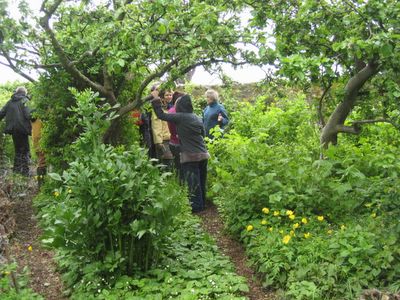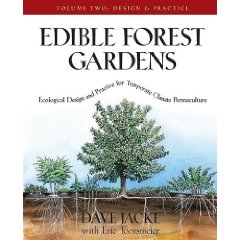
Forest garden ideas
 Edible forest gardening ---
the idea of mimicking natural ecosystems while providing tasty food ---
is something I'll probably be talking about a lot here for the next 6
weeks. I ordered three delicious books through interlibrary loan,
and I can already tell that I will be thinking of very little else
until I work my way through those 1,000 textbook-sized pages.
Edible forest gardening ---
the idea of mimicking natural ecosystems while providing tasty food ---
is something I'll probably be talking about a lot here for the next 6
weeks. I ordered three delicious books through interlibrary loan,
and I can already tell that I will be thinking of very little else
until I work my way through those 1,000 textbook-sized pages.
My library hasn't managed to find volume 1 of what seems to be the most
amazing of the forest gardening books, so I've started with volume
2 of Dave Jacke's Edible Forest
Gardens. I've only flipped through, looking at the
pictures, and then read the first 30 pages, but already I can tell that
this book will be my new religion. The ecology is astonishingly
sound and detailed --- not just talking about planting flowers to
attract beneficial insects, but listing which plants to use to attract
which specific beneficials. The 130 pages of plant lists in the
appendices tug at me, making me flip back and forth between lists and
text.
Now my mind is whirling with
ideas that I will try hard not to put into practice until I read at
least a couple of chapters and get more specifics. But already
I'm considering:
 Dealing
with my waterlogged areas by ditching,
and turning these ditches into wildlife and mulch habitat.
Dealing
with my waterlogged areas by ditching,
and turning these ditches into wildlife and mulch habitat.- Creating a mulch production portion of the garden where I grow perennial plants which I can cut back to use their leaves as mulch. Two categories of these:
- Nitrogen fixers (a category which doesn't just mean clover. In fact, the shrub-sized plants like alder look a lot better for my purposes!)
- Dynamic accumulators (which tend to have deep roots which suck up nutrients most plants can't get to. This category includes the obvious comfrey, but also some wetland plants we already have around that we could plant in our ditches, like horsetails and watercress. On dry land, herbs like yarrow, chives, lemon balm, and German chamomile also count.)
- Planning a more targeted approach to beneficial insect habitat by planting flowers that bloom throughout the growing season.
- Now this one is a stretch and a lot of hard work but...so enticing.... We could turn our perimeter fence project into a chicken moat --- put an additional fence four feet inside the outer fence, then run chickens in the middle. The fences can be joined with a trellis on top to provide grape and hardy kiwi habitat. The width makes even the most enterprising deer unable to jump over.
For the first time in over a year, I am considering buying a book. I probably won't though, because this book is listed at $75 (though "only" $47 at Amazon.) I apologize in advance for the long posts which will probably flow out of my computer as I read. Feel free to skim....
Want more in-depth information? Browse through our books.
Or explore more posts by date or by subject.
About us: Anna Hess and Mark Hamilton spent over a decade living self-sufficiently in the mountains of Virginia before moving north to start over from scratch in the foothills of Ohio. They've experimented with permaculture, no-till gardening, trailersteading, home-based microbusinesses and much more, writing about their adventures in both blogs and books.
Want to be notified when new comments are posted on this page? Click on the RSS button after you add a comment to subscribe to the comment feed, or simply check the box beside "email replies to me" while writing your comment.
- Remove comment
 I'll try to remember to post some hints from the books that can be used for small urban yards, because my understanding is that you don't have to live in the middle of the forest to make a forest garden.
I'll try to remember to post some hints from the books that can be used for small urban yards, because my understanding is that you don't have to live in the middle of the forest to make a forest garden.
- Remove comment
